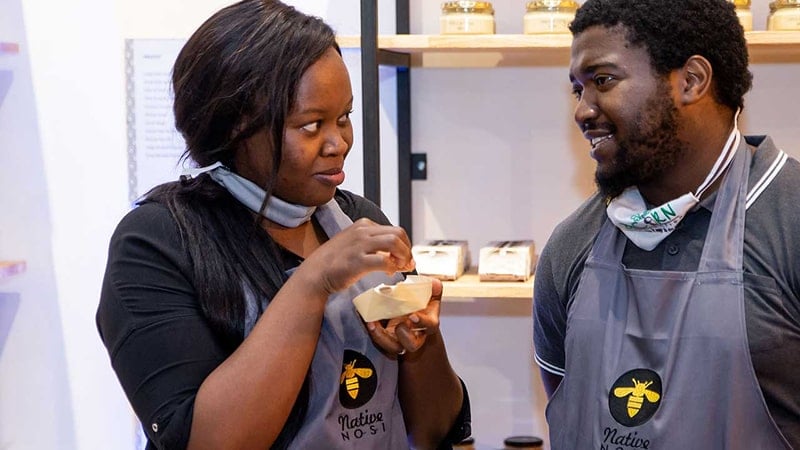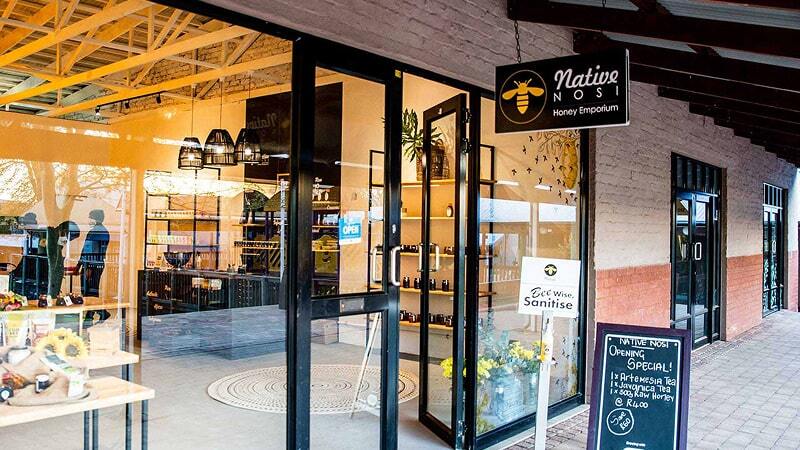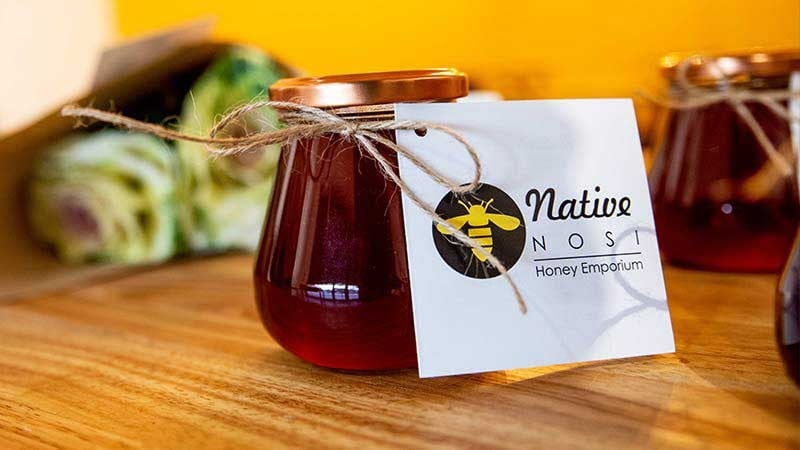

It’s just before 3:00 a.m. when Kattya Rodriguez slips through the Costa Rican darkness, winding through the quiet streets of San José to Panadería y Cafetería K&W, where for 15 years she’s baked bread, chocolate sweets, and pineapple cakes. Now she gets to work preparing for the morning rush. As she shapes dough with expert hands, the Tinkerbell tattoo that floats down her arm is a reminder of the magic she works every day.
Rodriguez is quick to say that some of that magic is a sprinkle of technology. K&W only accepted cash when she and her husband started the business, an effort to avoid the extra expense that came with accepting credit and debit cards. But they regularly lost customers who wanted to pay that way. Seven years in, the business became sufficiently profitable so that the extra costs wouldn’t affect earnings. Customers now have payment options.
But what gave K&W a real jump was an opportunity to be one of the first to test out a new mobile app, Conexión BP, before it publicly launched in December 2019.¹ It proved to be a game changer.
Small tap, big effects
The app’s Tap to Phone feature meant that customers could simply tap a card on the cashier’s mobile phone to pay for their baked goods. And — ping! like Tinkerbell’s wand — the sale went through. No extra machine to process cards; no paper receipts; and no direct contact, which became crucial once the COVID-19 pandemic hit.
“It really improved our business because the money went immediately into our account,” says Rodriguez in Spanish, her daughter Ariel translating. “And the lines moved faster, so we could serve more customers.”
The little tap that boosted Rodriguez’s sales tells a much larger story: the powerful effects that seemingly small innovations can have on increasing financial inclusion and entrepreneurship around the world.
“Our purpose at Visa is to uplift everyone, everywhere, by being the best way to pay and be paid,” says Todd Fox, president of the Visa Economic Empowerment Institute. “Handling physical cash consumes time and energy and adds friction at the point of sale. When entrepreneurs have the tools they need to securely accept contactless digital payments, they can focus on creating the products and services their customers love and generating the growth their communities need.”
The impact of contactless payments on economic growth is significant. A recent study² found that by speeding up checkout times, contactless payments generated $257M in benefits to merchants. Contactless payments make it possible to reach more customers, generating incremental sales growth. Another study³ found that contactless payments increased card transactions by 8.6 percent.
Payments innovation can also help increase financial inclusion. Approximately 1.4 billion people⁴ around the world lack access to a bank account, much less the financial tools to build a business like K&W. To reach that off-the-grid population — from the farmers in areas so remote banks don’t open branches to the workers stashing cash earnings in pots and pans — Visa has been partnering with a new breed of startups.

Following the mobile money
A dozen years before Conexión PB, a mobile money system known as M-PESA showed up in Kenya and upended the status quo. It was 2007 and thanks to M-PESA, people suddenly didn’t need a bank account to join the digital world of commerce. Instead, any user with a basic mobile phone could go to an M-PESA agent to turn bills and coins into mobile e-currency and also withdraw cash when needed. Since M-PESA’s debut, similar mobile money systems have sprung up in other developing countries.
“Digital payment innovation is not a zero-sum game,” says Fox. “Mobile money gave millions of individuals access to their first transaction account. That was the first step on a financial empowerment journey. Digital innovation puts all of these financial tools within reach.”
“If governments and the private sector work together, we can achieve universal financial access in the world,” says Fox. Innovation is expanding access to credit, making it easier to send and receive cross-border payments, and enabling individuals and small business owners to acquire practical money skills.
A growing body of research shows that mobile money fintechs have made inroads in that respect. Billy Jack, a professor of economics at Georgetown University, was living in Kenya when M-PESA launched in 2007, and has done several studies on the platform since. One published in Science in 2016⁵ showed that simply having access to mobile money lifted 2% of households in Kenya from extreme poverty. In other studies, Jack found that M-PESA helped people weather crises by being financially connected to more friends and family who, even from far away, are able to speedily zip over funds.
“The technology facilitates action at a distance, to misquote Newton,” Jack says.
M-PESA also helped boost education rates, he discovered. In that research, his team coached parents of graduating primary school students through signing up for bank accounts. Over the next six months, these accumulated a few dollars. That amount, however small, was enough to help the parents afford their children’s continued education. Indeed, the rate at which the parents enrolled their graduates into high school increased by about a third. “We didn’t give them anything,” he says. “We just helped them get a bank account. For people living in poverty, financial instruments — even very simple products — are really important. Without them, people stay stuck.”
A new dream
Today, Visa partners with a wide array of mobile money fintechs: Airtel Africa, Latin America’s Tigo Money, bKash in Bangladesh, and GoPay in Indonesia, to name a few. Visa also launched a new campaign last year with the Global System for Mobile Communications Association (GSMA) Mobile for Development Foundation.⁶ Its Digital Finance for All Initiative has a five-year goal to get 20 million unbanked people into the financial digital ecosystem, with a focus on women, smallholder farmers, micro-enterprise owners, and displaced persons.⁷
The initiative aims to apply lessons from past experience. It’s clear, for example, that financial illiteracy is a barrier to inclusion. Visa's long history of creating educational programs⁸ — including a financial football video game with the NFL and an educational comic book with Marvel — shows how important it is to customize the message. For example: connecting budgeting to a smallholder farmer’s harvest cycle, or borrowing to buy inventory that enables proprietors to sell at the market. When information is made relevant to individual circumstance, people are more likely to get and stay engaged.

Another roadblock to signing up for mobile money, GSMA’s research reveals, is the fear among women that strangers will contact them online. Visa hopes to ease that concern through its innovation in tokenization, which uses a unique digital identifier to mask and protect a person’s identity.
This newest effort is in line with other Visa drives like one in 2020 to digitize 50 million small and micro businesses to help them survive the pandemic⁹ — a goal it surpassed by 17 million, and in which Tap to Phone played a crucial role for customers who didn’t want to touch anything.
Public-private partnerships are important too. In another project, Visa worked with Ukraine’s Ministry of Digital Transformation in 2019 to launch a mobile app called Diia, which connects citizens to government services and allows them to digitally pay for items such as taxes.¹⁰ This app has proved especially useful during the continued invasion of Ukraine by Russia, allowing citizens to stay connected with vital resources despite disruptions.
“Financial inclusion is a big priority for us,” Fox says. “And then the goal is to get people moving up that financial services ladder so they become a more attractive customer to a bank for getting a loan, accessing a line of credit, and having working capital. For small and medium enterprises, that's a huge deal.”

Tapping into the bigger economy
Watching DJ Mokgadi Mabela work the turntables and move the crowd is to also understand the masterful way she orchestrates her honey business. When she’s not in headphones at a South African club, the third-generation beekeeper is running Native Nosi, which she started in 2015 in Pretoria. Despite the challenges that come with being a Black woman in an industry with few Black women, and in a difficult economy to boot, she’s grown her business on a trellis of payment innovations.
Like K&W, connecting to a local mobile fintech platform — in this case, Yoco, another Visa partner¹¹ — meant going from cash-only to options like cards and tap-to-pay. That helped Native Nosi grow to six employees who run a retail store, a catering arm, a retail website, approximately 300 buzzing hives, and a network of local beekeepers.
“Yoco can do everything!” says Mabela, “Swipe, phone tap, card tap. When you can give clients options, it increases your revenue. Yoco catapulted our business.”
Mabela is now able to dream of uplifting future generations. Aside from making people feel bliss with music and honey, she hopes to buy a farm, get investors, and continue growing Native Nosi. Her father manages the agricultural side; her husband pitches in when there’s a rush, and they’re raising two girls.
“We've had people interested in buying the business and we say, no — and it's not because we don't need the money!” Mabela says, stopping to laugh. “But we want to build something bigger than ourselves. We want to build a family legacy.”
- Visa. (2021) The Power of Tap to Phone Technology for Financial Inclusion.
- Charles River Associates. The Social Value of Innovation in Payments.
- Visa Economic Empowerment Institute. Why payment innovation matters for small businesses.
- World Bank Group. The Global Findex Database 2021: Financial Inclusion, Digital Payments, and Resilience in the Age of COVID-19.
- Science. (2016). The long-run poverty and gender impacts of mobile money.
- Visa. (2024, February). Visa and the GSMA Mobile for Development Foundation Launch Digital Finance for All Initiative.
- Visa. (2024). Digital Finance for All Initiative.
- Visa. (2022, April). Financial education for a more inclusive economy
- Visa. (2023, November). Visa Accelerates Support for Small and Micro Businesses Across APEC and Globally.
- Visa. (2023, May). ‘Diia can be a model for how governments approach digital transformation,’ Visa Executive Chairman Alfred F. Kelly, Jr. states at ‘Diia in DC’.
- Visa. From Small Business to Center of the Community.